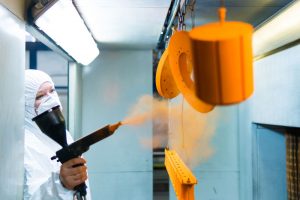Exploring the Versatile World of Powder Coating Application Methods

Powder coating has revolutionized the finishing industry with its eco-friendly, durable, and cost-effective solutions. Unlike traditional liquid coatings, powder coatings do not contain solvents, reducing the emission of volatile organic compounds (VOCs) and contributing to a greener planet. The application of powder coatings is a critical step in achieving the desired finish, and several methods are employed to cater to various industrial needs. This article delves into the primary powder coating application techniques, highlighting their unique features and applications.
Static Electrostatic Spray Coating
The most widely used method for powder coating is static electrostatic spray coating. This technique involves charging the powder particles with a static electric charge and applying them to a grounded object. The electrostatic attraction ensures that the powder adheres evenly to the object’s surface, resulting in a uniform coating. This method is favored for its high transfer efficiency, which means less waste of coating material and a more consistent finish. It’s commonly used in industries such as automotive, furniture, and general manufacturing.
Fluidized Bed Coating
Fluidized bed coating is another popular method, particularly suitable for objects with simple shapes and large surface areas. In this process, the powder is suspended in a chamber using a stream of air or gas, creating a fluid-like state. When the preheated object is dipped into the fluidized bed, the powder particles adhere to its surface. This method is known for creating thick, uniform coatings, making it ideal for applications requiring high corrosion resistance and insulation properties.
Thermal Spray Coating
Thermal spray coating involves heating the powder particles to a molten or semi-molten state before spraying them onto the substrate. This technique is often used for specialized industrial applications, such as applying wear-resistant or corrosion-resistant coatings. Thermal spray coatings can produce very thick layers, but they require skilled operators and are typically used in aerospace, energy, and heavy machinery industries.
Powder Dip Coating
Powder dip coating is a process where objects are dipped into a fluidized bed of powder and then removed. Excess powder is blown off, leaving a thin, even layer on the object. This method is particularly useful for complex shapes or when very thin coatings are required. It’s often used in electronics, small hardware, and medical device manufacturing.
Hand Spray Coating
Although less efficient than automated methods, hand spray coating is sometimes necessary for small batch productions or objects with complex geometries. This technique requires skilled operators who manually apply the powder coating using a spray gun. It allows for greater control and flexibility in coating intricate designs and hard-to-reach areas.
The choice of powder coating application method depends on various factors, including the object’s shape, size, the required coating thickness, and production efficiency. Each method has its unique advantages and is suited to specific industrial needs. As technology advances, the powder coating industry continues to innovate, offering even more efficient and effective solutions for surface finishing. Understanding these application methods can help manufacturers choose the best approach to achieve the desired finish, enhance product quality, and meet environmental standards.

 D5 Creation
D5 Creation